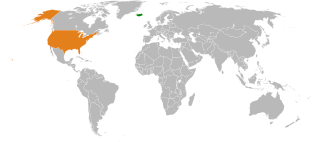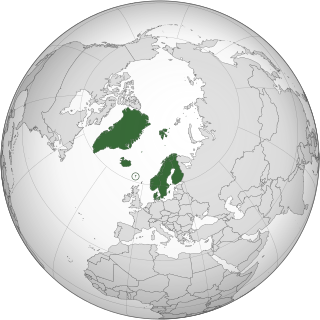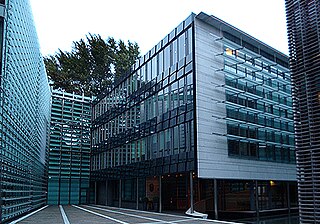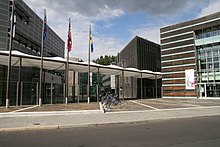Being part of the Kingdom of Denmark, the foreign relations of Greenland are handled in cooperation with the Danish government and the Government of Greenland.

Scandinavia is a subregion in Northern Europe, with strong historical, cultural, and linguistic ties between its constituent peoples. Scandinavia most commonly refers to Denmark, Norway, and Sweden. In English usage, it can sometimes also refer more narrowly to the Scandinavian Peninsula, or more broadly to all of the Nordic countries, also including Finland, Iceland, and the Faroe Islands.

The Nordic Council is the official body for formal inter-parliamentary Nordic cooperation among the Nordic countries. Formed in 1952, it has 87 representatives from Denmark, Finland, Iceland, Norway, and Sweden as well as from the autonomous areas of the Faroe Islands, Greenland, and Åland. The representatives are members of parliament in their respective countries or areas and are elected by those parliaments. The Council holds ordinary sessions each year in October/November and usually one extra session per year with a specific theme. The council's official languages are Danish, Finnish, Icelandic, Norwegian, and Swedish, though it uses only the mutually intelligible Scandinavian languages—Danish, Norwegian, and Swedish—as its working languages. These three comprise the first language of around 80% of the region's population and are learned as a second or foreign language by the remaining 20%.
Iceland took control of its foreign affairs in 1918 when it became a sovereign country, the Kingdom of Iceland, in a personal union with the King of Denmark. As a fully independent state, Iceland could have joined the League of Nations in 1918, but chose not to do so for cost reasons. It negotiated with Denmark to initially carry out most of its foreign relations, while maintaining full control. Denmark appointed a diplomatic envoy (Ambassador) to Iceland in 1919 and Iceland reciprocated in 1920, opening an Embassy in Copenhagen. Iceland established its own Foreign Service in April 1940 when Denmark became occupied by Nazi Germany and ties between the two countries were severed. The Republic of Iceland was founded in 1944. The Icelandic foreign service grew slowly in the post-WWII period, but increased rapidly after the mid-1990s. Iceland's closest relations are with the Nordic states, the European Union and the United States. Iceland has been a member of the United Nations since 1946. Iceland was a founding member of the World Bank in 1946 and NATO in 1949. In terms of European integration, Iceland was a founding member of the OEEC in 1948 and the Nordic Council in 1952, it joined EFTA in 1970, was a founding member of the CSCE in 1973 and the EEA in 1992 and joined Schengen in 1996.

The northern region of Europe has several definitions. A restrictive definition may describe Northern Europe as being roughly north of the southern coast of the Baltic Sea, which is about 54°N, or may be based on other geographical factors such as climate and ecology.
There are several long-established Nordic churches in London. All seek to provide Lutheran Christian worship and pastoral care to their respective national communities in their own languages. Many of the churches also organise language classes and organise a wide range of social activities.

The United States has maintained diplomatic relations with Iceland since the mid-1800s.
Nordischer Klang is the largest festival of Nordic culture in Germany. It is a major platform for artists from Denmark, Finland, Iceland, Norway, and Sweden in Germany. The festival takes place in the town of Greifswald, which is situated about 200 km to the north of Germany's capital Berlin at the Baltic shore.

Denmark and Norway have a very long history together: they were both part of the Kalmar Union between 1397 and 1523, and Norway was in a Union with Denmark between 1524 and 1814.

The Nordic countries are a geographical and cultural region in Northern Europe and the North Atlantic. It includes the sovereign states of Denmark, Finland, Iceland, Norway and Sweden; the autonomous territories of the Faroe Islands and Greenland; and the autonomous region of Åland.

Iceland–Sweden relations refers to the diplomatic relations between Iceland and Sweden. Both nations are mutual members of the Arctic Council, Council of the Baltic Sea States, Council of Europe, NB8, Nordic Council, Organisation for Economic Co-operation and Development and the United Nations.

The Embassy of Sweden in Berlin is Sweden's diplomatic mission in Germany. Ambassador since 2017 is Per Thöresson. Sweden established a legation in Berlin in 1912. During World War II, it was destroyed in aerial bombings and the legation was moved to other addresses in Berlin. After the war, the Swedish legation moved to Cologne in West Germany, and in the mid-1950s to Bonn, where it remained until 1999. During the Cold War, Sweden also had an embassy in East Berlin from the 1970s onwards. In 1999, the new Swedish embassy in Berlin was inaugurated and the one in Bonn was closed. The building complex in which the Swedish embassy is located since 1999 is called Nordic Embassies.










